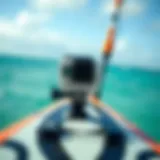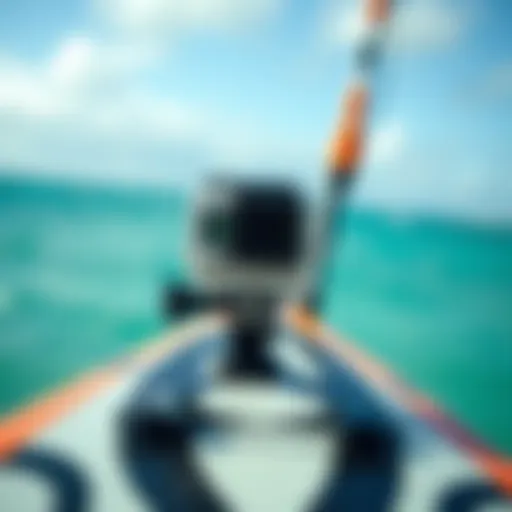Analyzing Kite Sales Trends in Kiteboarding
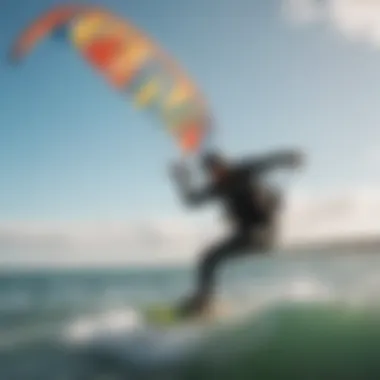

Intro
The kiteboarding market thrives on excitement and change, driven primarily by consumer choices and innovations in gear. As interest in kiteboarding continues to soar among thrill-seekers, understanding the dynamics of kite sales becomes essential for anyone involved in this sport, whether you’re a seasoned professional or a curious newbie. This section sets the stage for what follows, highlighting how gear selection, skill development, and seasonal trends interplay to shape the market.
Gear Selection
The first pivotal aspect of kiteboarding revolves around gear selection. Choosing the right kite and board is more than just personal preference; it can greatly influence performance and safety out on the water.
Types of Kites
There are various types of kites, each designed for different wind conditions and rider styles. Here’s a brief look at the main categories:
- C-Kites: Generally favored by freestyle and trick-oriented riders; they offer excellent power but require precise flying skills.
- Bow Kites: Known for their versatility, they provide good power and stability, making them ideal for beginners and advanced riders alike.
- Delta Kites: Featuring a unique shape that allows for a larger wind range; these kites are easy to handle and are excellent for light wind conditions.
- Hybrid Kites: Combining features from other types, hybrids cater to a variety of riding styles and conditions.
Understanding these types equips buyers with the insight they need to match their kite to their skill level and riding conditions.
Choosing the Right Board
Selecting a board goes hand-in-hand with choosing a kite. The board's size, shape, and material contribute significantly to a rider's experience. Here are the primary considerations:
- Size: Larger boards provide more buoyancy and easier ride, ideal for beginners or lighter winds. Smaller boards, on the other hand, are preferred by experienced riders for agility and speed.
- Shape: The outline of the board affects turning and carving capabilities. Directional boards, akin to surfing boards, are a popular choice for wave riding.
- Flex: The level of stiffness influences performance in varying water conditions; stiffer boards often provide more pop, while flexier boards offer a smoother ride.
Ultimately, matching the right board with the right kite enables a seamless riding experience, setting kiteboarders up for success.
"The combination of kite and board is crucial for enjoyment and safety in kiteboarding. Choose wisely and you can truly harness the wind!"
Skill Development
Once the gear is selected, the next phase is skill development. Mastery of essential techniques can elevate a kiteboarder’s confidence on the water, allowing for a more enjoyable experience.
Essential Techniques
Before hitting the waves, it’s wise to grasp several fundamental techniques. This includes:
- Launching and Landing: Proper techniques can prevent accidents and ensure a smooth start.
- Water Starts: Learning how to get up on the board quickly is essential for an enjoyable ride.
- Controlling the Kite: Understanding how to maneuver the kite in different wind conditions is crucial for effective riding.
- Riding Upwind: This skill helps maintain a position relative to the shore, making for less tiring sessions.
Progression Tips
As novices become more adept, setting progression goals can enhance their skills.
Some progression strategies include:
- Practice Regularly: Frequent sessions help reinforce learning.
- Seek Feedback: Learning from experienced instructors can provide insights that self-study might miss.
- Join a Community: Engaging with fellow kiteboarders fosters a supportive environment for shared learning and tips.
By emphasizing skill development alongside gear selection, kiteboarders can truly embrace the sport. The realm of kiteboarding is full of potential for growth and fulfillment, as long as one is willing to venture out and make the most of their time on the water.
Prelims to Kite Sales
Kite sales stand at the crossroads of innovation, leisure, and commerce within the kiteboarding market. Understanding the intricacies of this topic is vital for various stakeholders including consumers, retailers, and manufacturers. The kiteboarding industry has seen explosive growth over recent years, morphing into a dynamic market driven by a blend of technological advancements and shifting consumer behaviors. Tapping into this knowledge empowers enthusiasts to make informed purchasing decisions, while businesses can tailor their strategies for better alignment with market demands.
The Evolution of Kiteboarding Equipment
Looking back at the history of kiteboarding equipment reveals a fascinating transformation. In the early days, kites were rudimentary, often crafted from basic materials and lacking fine-tuning that modern technology now allows. As kiteboarding gained popularity, manufacturers began experimenting with designs, aerodynamic shapes, and materials, leading to improved performance and safety.
Fast forward to today, kites are engineered with precision, often utilizing advanced materials like ripstop nylon or even more exotic options like Dyneema for lines. Modern designs have shifted towards versatility—kites now accommodate various wind conditions, skill levels, and rider preferences. The shift from fixed-frame kites to inflatable models in the late 1990s revolutionized the sport. Not only did this enhance portability, but it also reduced the risk of injury, making kiteboarding accessible to a broader audience.
Understanding the Market Dynamics
Grasping the market dynamics surrounding kite sales opens a window into the factors that fuel growth in this sector. Elements like consumer preferences, seasonal trends, and the reputation of brands all play pivotal roles in shaping the landscape. Consumers today are more engaged and diligent; they often research extensively before making purchases, influenced by reviews, ratings, and community feedback. Social media platforms, forums, and dedicated communities allow for exchanges of ideas and experiences, leading to more informed decisions.
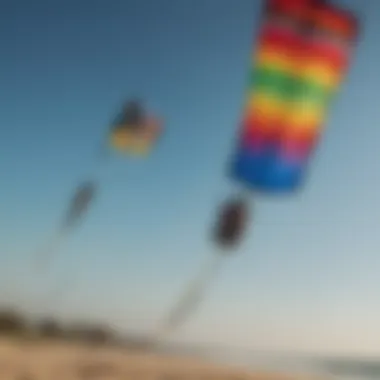

Brand reputation has become a double-edged sword; while a strong brand can attract a loyal customer base, any slip in quality or negative feedback can rapidly erode trust. Essentially, businesses must ensure they deliver not only superior products but also positive customer experiences.
Furthermore, several seasonal variations can significantly impact sales figures. The kiteboarding season typically sees peaks during spring and summer as conditions become favorable for outdoor activities. Retail strategies often pivot around these windows, meaning that companies gear up marketing efforts to capitalize on heightened consumer activity.
Key Factors Influencing Kite Sales
Understanding the factors that influence kite sales is essential for anyone interested in the kiteboarding market. This segment dives deep into the nuances that dictate consumer behavior and ultimately shape purchasing decisions. Knowing these dynamics helps retailers and manufacturers position their products better and meet customers' needs more effectively.
Consumer Preferences and Trends
Consumer preferences play a pivotal role in determining kite sales. Kiteboarding enthusiasts often seek the latest designs, optimal performance, and innovative technology. For example, many riders now gravitate towards kites that boast lighter materials and better aerodynamics, enhancing their riding experience.
Emerging trends such as eco-friendliness are reshaping consumer choices. Purchasers increasingly favor brands that exhibit a commitment to sustainability, opting for kites made from recyclable materials or produced through environmentally conscious methods. This trend isn’t just a passing phase; it reflects a broader societal shift towards responsible consumption. By riding this wave of preference, retailers have an opportunity to cater to these values and build customer loyalty.
"Listening to what customers want is half the battle in staying competitive in a crowded market."
Furthermore, there's a noticeable shift toward personalized equipment. Kiteboarders often look for customizable options tailored to their specific style, skill level, and local conditions. Retailers must keep an eye on these shifting preferences to stay relevant and win over consumer trust.
Impact of Brand Reputation
Brand reputation is another critical component influencing kite sales. In a market where trust is paramount, consumers lean towards brands with strong reputations for quality and reliability. Brands like North Kiteboarding or Duotone have cultivated loyal followings, partly due to their longstanding commitment to performance and innovation.
The kiteboarding community heavily relies on word-of-mouth recommendations and online reviews. Positive experiences shared on platforms like reddit.com can catapult a new kite brand into popularity overnight, while negative reviews can have a more significant detrimental impact. Thus, brands must maintain transparency and actively engage with their customers to build and sustain their reputation.
It's also essential for brands to align themselves with influential figures within the kiteboarding community. For instance, sponsorship deals with professional kiteboarders can enhance visibility and credibility, making their products more appealing to the average consumer. A kite that is endorsed by a well-respected athlete is likely to attract attention, creating a domino effect in consumer interest and sales.
Seasonal Variations in Sales
Sales of kites aren't static; they are significantly influenced by seasonal factors. Kiteboarding is inherently a season-bound activity, with different regions enjoying peak seasons at various times of the year. For example, warmer climates might see their busiest sales during the winter months, while places with more temperate conditions may experience spikes in sales as summer approaches.
Retailers must strategize around these cycles, planning inventory and marketing efforts accordingly. Many brands run promotional sales during off-peak seasons to stimulate consumer interest. For retailers, timing is everything. Understanding when to ramp up promotions or introduce new products can mean the difference between high and low sales volumes.
Every factor from consumer preferences to brand reputation and seasonal variations collectively shapes the kite sales milieu. By paying close attention to these dynamics, businesses can not only survive but thrive in the competitive kiteboarding landscape.
Choosing the Right Kite
Choosing the right kite is a pivotal element in the kiteboarding journey. A kite is much more than just a piece of equipment; it’s a direct extension of the rider's intentions and capabilities. Selecting the appropriate kite can influence performance, safety, and overall enjoyment on the water. Given the diversity in styles, designs, and purposes, understanding how to navigate these choices can lead to a significantly better experience for both novices and seasoned kiteboarders alike.
Types of Kites Available
When selecting a kite, the sheer variety available can be daunting. Here’s a rundown of the primary types:
- Hybrid Kites: These are a popular choice for many, combining characteristics of both C kites and bow kites. Their versatility makes them suitable for various conditions.
- C Kites: Best for experienced riders, C kites excel in performance trick execution. They tend to have a more aggressive feel, which can be thrilling for those who seek high-speed action.
- Bow Kites: Ideal for beginners, bow kites offer user-friendly characteristics providing great stability and ease of use. They're particularly good for lighter wind days.
Each type serves a certain purpose and caters to different skill levels. Understanding these will assist kiteboarders in aligning their preferences with suitable kites.
Factors to Consider in Selection
Making the right kite choice involves several key considerations that can enhance performance and enjoyment.
Size and Shape
The size and shape of a kite significantly affect its flying characteristics. Larger kites catch more wind, offering more lift but requiring more skill to manage. Conversely, smaller kites typically perform better in strong winds as they provide better control.
- Key Characteristic: The general rule here is that larger kites are great for light winds, while smaller ones are effective when the winds are strong.
- Unique Feature: This feature impacts how the kite behaves when moving upwind or during jumps. A well-sized kite for the given conditions can make all the difference between a thrilling session and a frustrating one.
Material Quality
The quality of materials used in kite construction greatly influences durability and performance. Higher-quality fabrics and stitching can withstand tougher conditions and last longer.
- Key Characteristic: Stronger materials will resist tearing and degradation due to UV exposure.
- Unique Feature: Materials like ripstop nylon or polyester are commonly used, which provides excellent strength-to-weight ratios.
- Advantages/Disadvantages: Investing in high-quality materials may increase upfront costs, but the longevity and performance can offset those expenses in the long run.
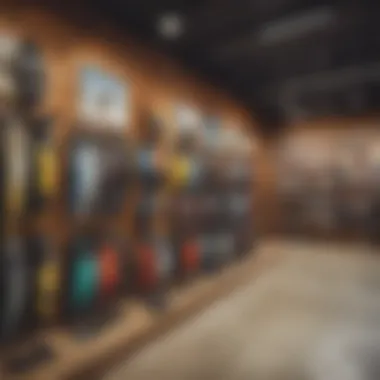

Skill Level Suitability
The suitability of a kite for a particular skill level cannot be overstated. Beginners genuinely benefit from kites designed for ease of use, providing stability and forgiving performance.
- Key Characteristic: Beginner-friendly kites offer features such as a larger wind range and better depower options.
- Unique Feature: Some kites now come with safety systems that prevent unintended releases, crucial for novices learning the ropes.
- Advantages/Disadvantages: A kite that’s too advanced for one’s skill level can lead to potentially dangerous scenarios, whereas the right selection fosters a positive learning curve.
Choosing the right kite can transform your experience in kiteboarding, enhancing not only your skills but also your enjoyment on the water.
By comprehending the types of kites available and the various factors to consider, kite enthusiasts can make informed decisions that elevate their time on the water, regardless of their experience level.
The Retail Landscape for Kites
The retail landscape for kites is a crucial element in understanding how kiteboarding gear reaches consumers. It reveals not only where enthusiasts can purchase their equipment but also how different retail strategies influence the buying journey. By dissecting this landscape, we can grasp how retailers impact kite sales in terms of availability, marketing, and consumer trust.
Online vs. Physical Stores
In the digital age, the tug-of-war between online and offline retail remains a dynamic aspect of kite sales. Online stores like Amazon and dedicated kiteboarding websites have gained a strong foothold, offering a wide selection of kites along with customer reviews and competitive pricing. This allows buyers to browse at their leisure, compare products, and make informed choices from the comfort of their homes.
However, physical stores have their own set of advantages. For instance:
- Hands-On Experience: Customers can touch, feel, and sometimes test gear before making a purchase, an experience that online shopping can’t replicate.
- Informed Assistance: Knowledgeable staff can offer personalized advice, guiding inexperienced buyers through the complex options available.
- Community Building: Local shops often host events or demos, fostering a sense of community among kiteboarders.
While the convenience of online shopping is undeniable, the tactile experience of visiting a physical store plays a vital role in the consumer’s decision-making process.
Role of Specialty Shops
Specialty shops serve as a cornerstone in the kiteboarding sales ecosystem. Unlike general sporting goods retailers, these shops focus exclusively on kites and related gear. This specialization brings benefits. Specialty shops often carry a curated selection that reflects current trends and innovations in kiteboarding. Staff at these locations are typically passionate kiteboarders themselves, which translates into informed customer service and expert recommendations.
Moreover, these shops are usually more involved in the kiteboarding community. They might host workshops or sponsor local competitions, which not only strengthens their brand but also enhances customer loyalty. A buyer looking to invest in a new kite might prioritize shopping at a specialty store to ensure they get quality advice tailored to their skill level and preferences.
Evaluating Retail Pricing Strategies
Pricing strategies in the kiteboarding market can be quite diverse, influenced by factors such as brand positioning, seasonal trends, and the competitive landscape. Online retailers often employ discount strategies to attract price-sensitive customers, using flash sales or seasonal promotions to move inventory. For example, end-of-season clearance sales can provide significant savings for buyers.
In contrast, physical stores might pursue a more stable pricing strategy that emphasizes values like customer service and community engagement. They may not offer the lowest prices, but they often provide added value through expert advice or loyalty programs.
To summarize, understanding the various retail pricing strategies is key for consumers looking to get the best bang for their buck. Here are a few considerations:
- Quality vs. Price: A lower price doesn't always indicate a better deal. It's important to consider quality and reliability.
- Warranties and After-Sales Support: Investing in a kite through a retailer that offers good after-sales service can lead to peace of mind.
- Price Match Policies: Some retailers will match online prices, offering the best of both worlds.
"The retail environment for kites not only shapes how products are sold but also affects consumer behavior as buyers seek quality, community, and value in their purchases."
Marketing Strategies in Kite Sales
In the competitive landscape of kite sales, effective marketing strategies are essential. These strategies not only help in reaching potential customers but also enhance brand visibility and loyalty. It's a complex interaction of creativity, analytics, and an understanding of the kiteboarding culture. A well-planned marketing approach can leverage trends and consumer behaviors, ultimately driving sales and fostering a vibrant kiteboarding community.
Leveraging Social Media
Social media platforms have reshaped marketing dynamics in recent years. They present kite brands with the opportunity to showcase products directly to potential customers. By utilizing engaging content such as videos of kiteboarding tricks, informative tutorials on gear selection, or even customer testimonials, brands foster a sense of community.
Some impactful strategies include:
- User-Generated Content: Encouraging customers to share their experiences and stunts while using their kites can create a buzz. It functions like digital word-of-mouth, appealing to potential buyers, especially younger demographics who are glued to their screens.
- Targeted Advertising: Platforms like Facebook and Instagram allow for precise audience targeting; brands can focus on kiteboarding enthusiasts, instructors, and event organizers specifically. This tailored advertising can lead to higher conversion rates.
- Influencer Marketing: Partnering with well-known kiteboarding figures or influencers with dedicated followings can lend credibility. Their endorsement can persuade fans to explore a brand they might have never considered before.
Leveraging social media isn't merely about posting; it's about fostering relationships, sharing knowledge, and nurturing passion for the sport.
Collaboration with Kiteboarding Events
Being present at kiteboarding events presents a golden opportunity for brands. Collaborations with event organizers can increase brand exposure significantly. Kite festivals, competitions, or clinics draw in crowds of enthusiasts eager to learn and engage.
Here’s how involvement at events can pay off:
- Product Showcases: Allowing potential customers to test kites can lead to immediate sales. When a kiteboarder feels the wind in their sails using a particular kite, they often commit to a purchase.
- Brand Workshops: Hosting workshops to educate consumers about the nuances of their products not only positions a brand as a leader in quality but also builds trust with the audience.
- Networking Opportunities: Events are prime spots for developing connections with retailers, instructors, and fellow brands, establishing a community that could lead to further collaborations in the future.
"Participation in kiteboarding events fosters relationships which are just as vital as the sales itself. Customers don’t just buy a product; they invest in a lifestyle and a community."
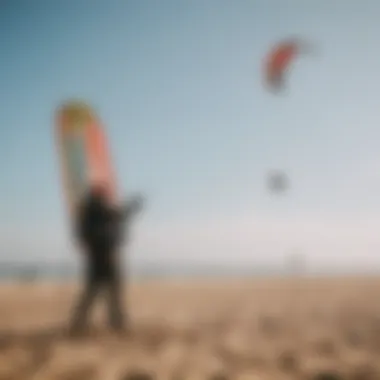

Influencing Consumer Behavior through Sponsorships
Sponsorships can significantly shift consumer behavior. When brands fund professional kiteboarders or events, they invest in visibility and credibility. Kiteboarders often follow their favorite riders closely, absorbing their recommendations on gear.
Key considerations for effective sponsorships include:
- Aligning Brand Values: Sponsoring athletes or events that share similar values and target demographics is crucial. This alignment ensures that the message is authentic, resonating well with the audience.
- Long-term Partnerships: Rather than one-off sponsorships, long-term partnerships help in building a consistent brand image. Regular interactions and endorsements from a sponsored athlete can create a sense of trust and reliability among consumers.
- Engagement Strategies: Building campaigns around sponsored athletes, like behind-the-scenes footage or gear maintenance tips, can personalize the athlete’s experience for fans, influencing their purchasing choices.
In summary, effective marketing strategies are essential for navigating the complex kite sales landscape. By leveraging digital platforms, collaborating with events, and engaging through sponsorships, kite brands can resonate with consumers, ultimately influencing their decisions and enhancing customer loyalty.
Ethical Considerations in Kite Sales
As the kiteboarding industry continues to grow, so too does the conversation around ethical considerations in kite sales. Understanding these factors is paramount for manufacturers, retailers, and consumers alike. The industry is not just about selling kites and gear; it's also about ensuring that the processes involved are responsible and sustainable.
Environmental Impact of Production
Kite production often involves materials that can have significant ramifications for the environment. Many kites are made from synthetic fibers and plastics. The environmental footprint of producing these materials can be hefty, affecting air quality and contributing to pollution. It's crucial for companies to seek out sustainable practices, like using recycled materials or environmentally friendly production methods.
For example, brands like Naish and Cabrinha have begun integrating eco-friendly materials in their manufacturing processes. By making an effort to reduce waste and select more sustainable fabrics, these companies are paving the way for more environmentally-responsible kiteboarding practices. Additionally, adopting a cradle-to-cradle model where kites can be recycled or repurposed can minimize their impact on the environment by reducing landfill contributions.
Why this matters:
By choosing eco-friendly products, consumers can encourage companies to prioritize sustainability in their operations.
Making informed choices promotes a healthier environment and supports brands that make conscious efforts toward reducing their ecological footprint.
Safety Standards and Regulations
Safety must always come first when it comes to kiteboarding. The thrill of riding the waves should never come at the expense of safety. Kite manufacturers and retailers need to adhere to stringent safety standards to ensure their products meet regulatory requirements. This includes the use of quality materials, reliability in design, and passing safety tests that evaluate the kites’ performance under various conditions.
Regulatory bodies exist in many regions to enforce these standards. For instance, the International Kiteboarding Association has established guidelines that manufacturers can follow. Retailers also place a role by offering only those kites that are compliant with these safety standards. Some retailers might even conduct additional inspections to ensure a kite’s reliability before it hits the shelves.
"A well-made kite could mean the difference between a graceful flight over the water and a dangerous incident."
Consumers must educate themselves on safety certifications to choose gear that is both top-notch and compliant with regulations. Additionally, participation in kiteboarding lessons from certified instructors can familiarize enthusiasts with equipment, promoting not only fun but also a safe ride.
In summary, ethical considerations in kite sales extend beyond the sales pitch and delve into a manufacturers’ responsibility toward the environment and safety. Consumers and retailers alike benefit from understanding these elements, ensuring a thriving kiteboarding ecosystem that respects nature and prioritizes rider safety. Engaging with brands that are committed to these values can help to shape the industry's future.
The Future of Kite Sales
Understanding the future of kite sales is crucial for stakeholders across the kiteboarding spectrum. Be it manufacturers, retailers, or enthusiasts, anticipating market dynamics helps in making informed decisions that lead to greater success. As we look ahead, several specific elements come into play that could dramatically influence both sales and the overall experience of kiteboarding.
Trends Shaping the Industry
A few trends are beginning to brew in the kiteboarding market. First up, we got sustainability. Consumers are becoming more eco-conscious, choosing gear that’s made with environmentally friendly materials. Kite brands that prioritize green practices not only boost their appeal but also can often command higher prices.
There's also a noticeable movement towards customization. Enthusiasts are seeking unique kites tailored to their specifications. This opens avenues for brands willing to invest in personalized gear. To stand out, companies might consider offering bespoke options that tap into the individuality of kiteboarders.
Here’s a quick rundown of some significant trends:
- Sustainable materials: Brands using recycled or organic materials in their kites.
- Customization options: Providing tailor-made kites for enthusiasts who want a personal touch.
- Growing e-commerce: The influx of online stores pushing traditional retailers to adapt.
Technological Innovations
When it comes to technology, innovations are revolutionizing kite performance and user experience. For instance, brands are experimenting with new materials that increase durability while reducing weight. Paragliding technology, such as advanced wing designs, are spilling over to kites, enhancing lift and control.
Another notable shift is the integration of smart tech. Imagine kites equipped with sensors that give real-time feedback about wind conditions and performance metrics. It’s not unexpected that these advancements could attract a younger crowd keen on blending sports with technology.
Consider these innovations:
- Smart kites with sensors for feedback on performance.
- Durable yet light materials for better handling in various conditions.
- Augmented Reality apps for enhanced training and learning.
Predictions for Consumer Demand
Looking into the crystal ball, several forecasts emerge regarding consumer demand in kite sales. With the increasing popularity of kiteboarding as a sport, the number of newcomers is likely to swell. This surge could lead to a broader market for entry-level kites at affordable price points, catering to those just dipping their toes in the water, figuratively speaking.
Additionally, as kiteboarding continues to establish itself as a prestigious sport, the demand for premium gear is expected to rise. Buyers are willing to splurge on high-end products when they believe quality and performance are justified. While there may always be a segment of the market focused on cost, a more discerning clientele looks for excellence.
In summary, anticipated shifts in the kite sales landscape will likely include:
- Increased entry-level options to accommodate new participants.
- Higher-quality premium gear being in demand due to increased competition among brands.
- A strong influence of technology steering purchasing decisions.
"To stay ahead, manufacturers and retailers will need to keep their ears to the ground and adapt quickly to consumer preferences and technological advancements."














